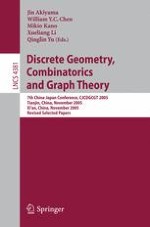2007 | Buch
Discrete Geometry, Combinatorics and Graph Theory
7th China-Japan Conference, CJCDGCGT 2005, Tianjin, China, November 18-20, 2005, Xi’an, China, November 22-24, 2005, Revised Selected Papers
herausgegeben von: Jin Akiyama, William Y. C. Chen, Mikio Kano, Xueliang Li, Qinglin Yu
Verlag: Springer Berlin Heidelberg
Buchreihe : Lecture Notes in Computer Science
